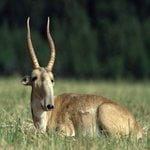You will recognize them by their large oversized nose called a proboscis which is thoug ht to help cool the hot desert air and also heat the frozen air entering the lungs. Saiga are listed as a critically endangered by the union for the Conservation of Nature after their numbers fell to to less than 21,000 in the 1990’s. Their odds of survival improved as their numbers grew to 257,000 with a herd in Kazikhstan and Russian and Mongolia.
ht to help cool the hot desert air and also heat the frozen air entering the lungs. Saiga are listed as a critically endangered by the union for the Conservation of Nature after their numbers fell to to less than 21,000 in the 1990’s. Their odds of survival improved as their numbers grew to 257,000 with a herd in Kazikhstan and Russian and Mongolia.
All that came to an end with the shocking die off of 60,000 antelope in just 4 days this year. Within one month 134,000 of the animals lay dead wiping out two herds some 300km apart simultaneously. These deaths of one third of the worldwide population are catastrophic and a United Nations backed effort known as CM S statement confirmed that “not a single animal survived in the affected herds” Researchers are baffled as to the reason “The extent of this die-off, and the speed it had, by spreading throughout the whole calving herd and killing all the animals, this has not been observed for any other species,” said Steffen Zuther, a geoecologist and coordinator of the Atlyn Dala Conservation Initiative. “It’s really unheard of. The question is why it developed so rapidly and why it spread to all the animals?”The few remaining antelope now still face is historic enemies – wildlife crime and poaching, so the odds of their survival look bleak.
S statement confirmed that “not a single animal survived in the affected herds” Researchers are baffled as to the reason “The extent of this die-off, and the speed it had, by spreading throughout the whole calving herd and killing all the animals, this has not been observed for any other species,” said Steffen Zuther, a geoecologist and coordinator of the Atlyn Dala Conservation Initiative. “It’s really unheard of. The question is why it developed so rapidly and why it spread to all the animals?”The few remaining antelope now still face is historic enemies – wildlife crime and poaching, so the odds of their survival look bleak.
Meanwhile back at home……the Honey Bee Colony Collapse Disorder (CCD) has a huge impact on our food production since they pollinate most of our crops. Two thirds of crops require pollination by bees — that’s one out of every three bites of food we take. The droughts across the West are impacting their populations. A dangerous new pattern in the bee crisis is alarming researchers and advocates. For the first time ever, beekeepers are losing more bee colonies during summer months than the cold winter months. Beekeepers have reported losing more than 40 percent of their honey bee colonies over the last year, according to a recently released survey.
Nature is feeling the strain of fewer resources stretched by a larger population with growing needs of water, arable land and materials. We are consuming more and also wasting more. We have caused 322 animal extinctions over the past 500 years, with two-thirds of those occurring in the last two centuries, according to a paper by the Journal of Science.
I wonder what the Creator thinks when He looks at what we have done? Gen 1 v 31 And God saw everything that He had made, and behold, it was very good.……….Six times God reviewed every days creation and concluded….It was very good. He then turned over the beauty of all He had made for man to keep and take care of…. Gen 2v15 Then the LORD God took the man and put him into the garden to cultivate it and keep it.
Today God listens to the groans of His Creation Is 24 v5 The earth dries up and withers, the world languishes and withers, the heavens languish with the earth. 5 The earth is defiled by its people; they have disobeyed the laws….
What will we say when He calls us to account for our management of His planet?